UP Board Notes for Class 10 Science Chapter 6 Photosynthesis Learning Objectives
After completing this chapter, you will be able to:
- Define the term photosynthesis;
- Describe the importance of photosynthesis for living beings;
- Construct the generalized equation of photosynthesis;
- List the raw materials required for photosynthesis and describe the role of chlorophyll;
- Describe the structure of chloroplast and the functions of its various parts;
- Explain what happens in the light-dependent reactions and light-independent reactions of photosynthesis and list the end products of the two reactions;
- Describe various factors affecting photosynthesis;
- Give suitable experiments to prove the raw materials required and products formed as a result of photosynthesis;
- Describe carbon cycle occurring in nature.
You know that all green plants can synthesize their own food from simple inorganic raw materials through photosynthesis. Hence, green plants are called producers or autotrophs and the mode of nutrition in green plants is called autotrophic nutrition. In this chapter, you will study about photosynthesis and its importance for life.
UP Board Notes for Class 10 Science Chapter 6 Photosynthesis What Is Photosynthesis?
Photosynthesis
Photosynthesis is a biochemical process by which living cells of plants containing chlorophyll manufacture their own food (glucose) using carbon dioxide and water as raw materials in the presence of light energy. Oxygen is released as a by-product of photosynthesis. Photosynthesis is an important activity that occurs in all green plants.
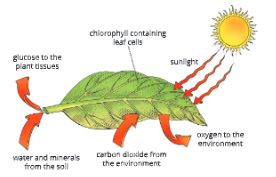
Photosynthesis is the only process by which solar energy is converted into chemical energy.
All living beings depend on photosynthesis for two reasons.
| Class 10 Science | Class 11 Chemistry |
| Class 11 Chemistry | Transformation of Sentences |
| Class 8 Maths | Class 8 Science |
- For food prepared by plants, and
- For oxygen is released as a by-product.
Significance of photosynthesis
- Photosynthesis provides food for all. The process of photosynthesis occurs in green plants which are the primary producers in a food chain.
- Photosynthesis is the ultimate biological source of oxygen and energy for all living beings on earth. It is essential for sustaining life.
- It is necessary for the synthesis of organic compounds from inorganic compounds.
- It takes in atmospheric carbon dioxide (given out during respiration and other activities) and releases oxygen.
UP Board Notes for Class 10 Science Chapter 6 Photosynthesis Raw Materials For Photosynthesis
To perform photosynthesis, plants require carbon dioxide (CO₂), water (H₂O), light energy, and chlorophyll. CO₂ and H₂O serve as raw materials and sunlight serves as a source of energy. The process of photosynthesis takes place in chloroplasts.
Carbon dioxide
The main source of CO₂ for land plants is the atmosphere, which contains 0.03-0.04 percent of CO2. Aquatic plants use CO₂ dissolved in water. Two main processes, photosynthesis, and respiration take place side by side but photosynthesis does not take place in the absence of light whereas respiration continues throughout the day and night.
CO2 Compensation Point
During the day when the light intensity is high, the rate of CO₂ consumption for photosynthesis is higher than that of CO₂ liberation by respiration in plants, hence, CO₂ is continuously absorbed from the atmosphere through stomata.
During morning and evening hours, the intensity of light is usually low. At this time, a stage may come when CO₂ liberated during respiration in plants is equal to CO₂ used in photosynthesis. At this stage, no exchange of CO₂ takes place between the environment and plants. This stage is known as the compensation point.
Water
Plants absorb water from the soil by their root hair. This water is then transported up to the stem and leaves through the xylem vessels. Aquatic plants absorb water through their general body surface because they have poor root system.
Water rarely serves as a limiting factor in photosynthesis because less than 1 percent of the water absorbed by a plant is used in photosynthesis.
Light
Light is very important for photosynthesis. In photosynthesis, light energy of the sun is converted into chemical energy. The sun is the main source of light energy. Artificial light is also effective in photosynthesis but this light should be of a required intensity.
The rate of photosynthesis is affected both by the quality as well as the quantity (intensity and duration) of light. Too much light intensity may destroy chlorophyll. In red-colored light, the rate of photosynthesis is maximum, whereas in green-colored light, photosynthesis does not occur.
UP Board Notes for Class 10 Science Chapter 6 Photosynthesis Chlorophyll – The Photoreceptor to Trap Solar Energy
Leaves contain chlorophyll which is a photoreceptor molecule. Chlorophyll absorbs photons unit of sunlight. Chlorophyll is present in the chloroplast. Chloroplasts are green-colored plastids containing chlorophyll pigments and are mostly present in leaves That is why leaves are called photosynthetic organs.
Chloroplasts are also present in young stems and fruits. A cell may contain about 40-50 chloroplasts and a leaf may contain more than 500000 chloroplasts per sq mm of leaf surface. The green color of the plants is due to the chlorophyll.
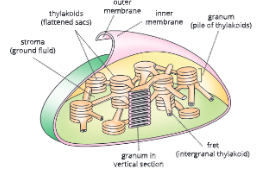
The internal structure of a chloroplast as seen through an electron microscope
UP Board Notes for Class 10 Science Chapter 6 Photosynthesis Structure Of Chloroplasts
A Chloroplast has three parts:
A double membrane envelope covers each chloroplast. There is a minute space available between the membranes. The membranes are selectively permeable.
- Stroma: On the inside, the lumen of chloroplast is filled with a colorless ground substance or matrix called the stroma.
- Thylakoids: Thylakoids are flattened membranous sac-like structures present in stroma. These thylakoids are stacked over one another like a stack of coins. A pile of thylakoids is called grana (singular: granum).
The closely packed thylakoids arranged in piles are called grana.
The grana are connected to each other by interconnecting bars or lamellae called fret or stroma lamellae.
The chlorophyll pigment is contained in the membranes of the thylakoids. Chloroplasts are mainly located in the mesophyll cells between upper and lower epidermis (palisade and spongy cells) of leaves. Guard cells of stomata also contain chloroplasts.
Chlorophyll is mainly of nine types. Of these, chlorophyll a and chlorophyll b are most important as they receive solar energy to bring about splitting of water. Chlorophyll is composed of carbon, oxygen, hydrogen, nitrogen, and magnesium. Water passes into the palisade cells of mesophyll tissue by osmosis from the xylem and carbon dioxide diffuses in from the atmosphere.
Location and functions of some structures

Sunlight is absorbed by the chlorophyll. By using this energy, carbon dioxide and water are utilized in the chloroplast with the help of a number of enzymes to yield sugar which is readily converted into a storable form of food, starch. The oxygen formed in the reaction diffuses out of the cells and is released into the atmosphere through the stomata.
UP Board Notes for Class 10 Science Chapter 6 Photosynthesis Opening And Closing Of Stomata
Stomata (singular: stoma) are minute pores present either on the lower or both the surfaces of the leaf to facilitate the exchange of gases (CO₂ and O₂) between the leaf and the atmosphere.
Each stoma consists of a stomatal aperture and two surrounding guard cells. The guard cells are kidney-shaped and contain chloroplasts. The inner wall of each guard cell is thick and outer wall is thin.
There are two theories for opening and closing of stomata, namely
- sugar concentration theory and
- K+ ion concentration theory.
Sugar concentration theory
This is an old theory. During the daytime, the cell-sap concentration becomes high due to the accumulation s increased and of sugar. As a result, osmotic pressure water is drawn inside the guard cells from adjoining cells due to endosmosis.
This makes guard cells turgid so that their thin outer walls get stretched and bulge outside. This widens the stomatal pore causing the opening of stomata. The pressure developed in guard cells is turgor pressure.
As the stomata open, the diffusion of gases takes place and CO₂ is let in and O₂ is let out.
During the night, when there is no photosynthesis, carbon dioxide gets accumulated in guard cells.
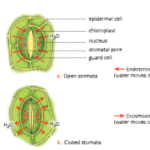
Stomatal apparatus opening and closing of stomatal pore.
This carbon dioxide then combines with water to form carbonic acid which has a pH of 5.0. It then converts the sugar into starch which is insoluble in water. As a result, exosmosis takes place and guard cells become flaccid or lose turgidity. Thus, the slit-like stomatal pore narrows down. The inner thick walls straighten and stomata close.
Potassium ion (K*) concentration theory
Recently a new theory of opening and closing of stomata has come into existence. According to this theory, opening and closing of stomata depend on the generation of potassium ion (K+) gradient.
Opening of stomata: During daytime, photosynthesis takes place inside chloroplasts in the guard cells as a result of which ATP is produced. This ATP helps in the pumping of potassium ions (K+) of the adjoining cells into the guard cells. As a result, the concentration of K+ions increases in the guard cells making them hypertonic. Thus, more water from the adjacent cells move into the guard cells making them turgid. The guard cells open out leading to the opening of stomata.
Closing of stomata: During night, just opposite happens. The ATP formation stops during night as no photosynthesis is taking place. Thus K ions move out of guard cells leading to hypotonic condition. The water moves out of the guard cells and they become flaccid, leading to closing of the stomatal pore.
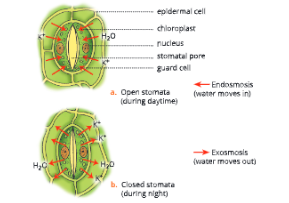
How are the leaves adapted for photosynthesis?
- Large surface area: Leaves have large surface area for maximum absorption of light.
- More number of stomata: Leaves have more number of stomata to allow rapid exchange of O₂ and CO₂ gases.
- Arrangement of leaves at right angles: Leaves are arranged at right angles to light source so as to trap maximum light.
- Concentration of chloroplasts on upper epidermis: Chloroplasts are more concentrated on the upper epidermis of the leaf so as to obtain maximum light energy.
- Extensive vein system: The vein system is extensively developed for rapid transport of water to and from mesophyll cells.
- Thinning of leaves: This reduces distance between cells for faster transport of gases and water.
UP Board Notes for Class 10 Science Chapter 6 Photosynthesis The Mechanism Of Photosynthesis
As already discussed in the previous section, mesophyll tissue in a leaf is the principal site of photosynthesis. Mesophyll tissue is differentiated into palisade and spongy tissue. Water is transported into palisade cells by cell-to-cell osmosis from xylem tissues and carbon dioxide diffuses in from the atmosphere. Sunlight is absorbed by the chlorophyll of the upper layers of mesophyll cells.
By using the light energy from sunlight, carbon. dioxide and water are combined in the chloroplast with the help of a number of enzymes to yield sugar (glucose). It is readily converted into a storable form, starch. The oxygen evolved in this process is given out in the atmosphere through stomata.
The overall chemical equation of photosynthesis is as follows:
6CO₂ +12H₂O ————- > C6H12O6 + 6H₂O +60₂
The six molecules of H₂O liberated at the end of the reaction are those that have been re-formed during chain of reactions in this process.
Phases of photosynthesis
There are two phases of photosynthesis:
- the light-dependent phase and
- the light-independent phase (dark phase).
Light-dependent phase or reaction – Hill’s reaction (Photochemical phase)
This is the photochemical phase of photosynthesis. As the name suggests, this is a light-dependent reaction, that is, light plays a key role in this reaction. This reaction takes place in the thylakoids of the chloroplasts.
A series of chemical reactions occur in quick succession, initiated by light. The main steps of this reaction are as follows.
Step 1: Excitation or activation of chlorophyll
- The photosynthetic pigments (chlorophyll) absorb light energy in the form of photons (smallest unit of light energy).
- After being exposed to photons, the chlorophyll molecule gets activated and emits electrons, which travel through electron transport chain in chloroplasts.
Step 2: Splitting of water (Photolysis)
The splitting of water, also known as photolysis (Gk. photo: light, lysis: breaking), takes place in a light reaction during which water is broken down into highly reactive hydrogen (H) ions and oxygen and electrons (e) are emitted. These electrons travel through the electron transport chain in chloroplasts.
2H₂O energy of 4 photons———–> 4H+ + O₂ + 4e¯
The free oxygen is the oxygen gas given off during photosynthesis.
Photolysis
The splitting of water (H₂O) molecules into hydrogen (HT) ions and oxygen in the presence of light energy is called photolysis. It takes place inside grana.
Step 3: Formation of ATP from ADP (Photophosphorylation)
The above-mentioned reactions in step 1 is mediated by electron acceptors, and adenosine triphosphate (ATP) is synthesized from adenosine diphosphate (ADP) and inorganic phosphate (Pi). In other words, electrons are used to convert ADP into ATP by adding one inorganic phosphate, Pi. This is known as photophosphorylation [addition of phosphate in the presence of light (photons)]. This ATP is used during dark reactions.
ADP + Pi + e + energy → ATP
End products of photolysis
- NADP (Nicotinamide Adenine dinucleotide phosphate) is reduced to NADPH: The released H+ (hydrogen ions) are picked up by NADP molecule to form NADPH (reduced form of NADP).NADP+ + 2e + H+- enzymes —— > NADPH
- The oxygen (O) is given out as molecular oxygen (0₂).
20 → O2
Light-independent phase – Calvin cycle (Dark reaction or Biosynthetic phase)
This is the biosynthetic phase of photosynthesis. The dark reaction occurs in the stroma of chloroplasts. This reaction does not require light energy, but it does not mean that t occurs during dark only.
This is a light-independent reaction. The dark reaction occurs simultaneously with the light reaction and the time gap between the two is less than one-thousandth of a second. In the dark reaction, the following steps take place:
- NADPH molecules and ATP molecules, both
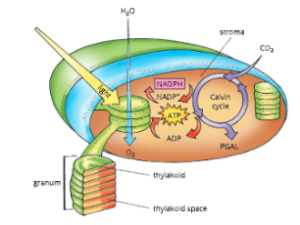
Summary of light and dark reactions. The light reactions occur in thylakoids of chloroplasts where sunlight is captured, water is split and oxygen is given out, and ATP and NADPH are produced.
The dark reactions occur in stroma of chloroplasts, where carbon dioxide is fixed and reduced after being incorporated into the Calvin cycle. Reduction uses the ATP and NADPH from the light reactions. produced during light reaction are utilized to produce sugar (C6H12O6) from carbon dioxide.
- Reduction of carbon dioxide occurs in the stroma of the chloroplast by means of a series of reactions known as the Calvin cycle during which fixation and reduction of carbon dioxide take place.
The fixation of CO₂ is catalyzed by the enzyme Rubisco (Ríbulose-1, 5-bisphosphate carboxylase).
The overall process of a sequence of events taking place in a plant cell during photosynthesis are shown in.
Water is transported into palisade cells by cell-to-cell osmosis. CO₂ diffuses in from atmosphere.
Photons (light energy) from sunlight absorbed by chlorophyll in chloroplast.
Chlorophyll absorbs light energy (photons)
↓
Chlorophyll molecule gets activated
↓
Photolysis: Splitting of water molecules into highly reactive
H+ ions and O₂
2H₂O → 4H* + O₂ + 4e¯
↓
ATP formed from ADP
ADP + Pi + energy → ATP
↓
NADP+ reduced to NADPH
↓
Fixation of CO₂ by enzyme Rubisco
↓
Sugar (C6H₁2O6) produced from CO₂. NADPH and ATP catalyze the reaction. (Calvin cycle)
↓
Glucose either immediately used by cells or stored as starch.
A simple flowchart to show the process of photosynthesis in plants.
UP Board Notes for Class 10 Science Chapter 6 Photosynthesis Photosynthesis Factors Affecting Photosynthesis
There are a number of factors affecting the rate of photosynthesis. These factors are categorized as follows:
external factors:
- light intensity
- carbon dioxide concentration
- temperature
- water availability
internal factors:
- chlorophyll
- leaf structure
- protoplasm
UP Board Notes for Class 10 Science Chapter 6 Photosynthesis Photosynthesis External Factors
- Light intensity: The rate of photosynthesis increases linearly with an increase in the intensity of light and then stabilizes at a point of 0.02% of CO₂. However, extremely high intensities of light do not increase the rate of photosynthesis. Optimum light intensity for photosynthesis varieswith the species of the plant. In fact, very strong light intensity may bleach chlorophyll and retard photosynthesis.
- Carbon dioxide concentration: In normal conditions, carbon dioxide is the major limiting factor in photosynthesis. The rate of photosynthesis increases with an increase in the CO₂ concentration. The concentration of CO₂ in the atmosphere varies from 0.03 to 0.04 percent. A concentration of 0.02 percent of CO₂ for a short duration is optimum for increasing the rate of photosynthesis. However, over long periods, even 0.05 percent CO₂ concentration in the atmosphere can increase the rate of photosynthesis, provided the light intensity is also increased to support it.
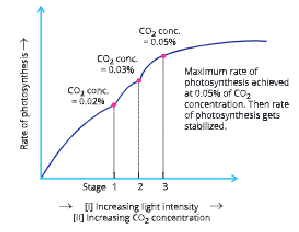
Effect of increasing light intensity and CO₂ concentration on rate of photosynthesis.
Stage 1: Limited light intensity and at CO₂ concentration of 0.02% (In a normal condition) the rate of photosynthesis gets stabilized.
Stage 2: Rate of photosynthesis gets further increased with an increase in light intensity and CO₂ concentration of 0.03%.
Stage 3: Rate of photosynthesis is maximum at CO₂ concentration 0.05% along with maximum light intensity. Then at this point, the rate of photosynthesis gets stabilized.
- Temperature: In general, an increase in temperature results in an increase in the rate of photosynthesis when other factors are not limiting. Photosynthesis is restricted to a temperature range in which the enzymes remain active. Further, a rise of 10 °C up to the optimum temperature (35 °C) doubles the rate of photosynthesis, for example, a rise from 20 °C to 30 °C or 25 °C to 35 °C doubles the rate of photosynthesis. The maximum suitable temperature when photosynthesis occurs best is about 35 °C above which the rate falls. The process of photosynthesis falls and stops above 40 °C as the enzymes get destroyed. Similarly, low temperature also inhibits enzymatic activity and rate of photosynthesis is reduced.
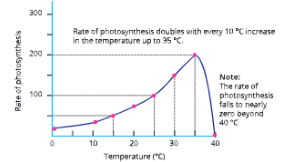
Effect of temperature on the rate of photosynthesis
- Water: Less than 1 percent of the total water absorbed by plants is utilized as a raw material in photosynthesis. Water rarely becomes a limiting factor in photosynthesis.
Internal factors
- Chlorophyll: Inadequate amount of nutrients like minerals causes loss of chlorophyll in leaves thereby reducing the trapping of solar energy. As a result, the rate of photosynthesis is reduced.
- Structure of leaf: The size and thickness of the leaf, and distribution of stomata influence the amount of CO₂ and light entering the leaf.
- Protoplasm: Dehydration of protoplasm and accumulation of sugar and starch in the leaves reduce the rate of photosynthesis.
Rate Of Photosynthesis
(Blackman’s principles of limiting factors)
The three main conditions affecting the rate of photosynthesis, also known as Blackman’s principles limiting factors, are as follows:
- Optimum condition: CO₂ conc. 0.03% -0.05%, more light intensity and optimum temperature (35 °C) – More photosynthesis
- More light intensity, optimum CO₂ but low temperature -Less photosynthesis
- More light intensity, less CO₂ and optimum temperature – Less photosynthesis
- Less light intensity, optimum CO₂, and optimum temperature – Less photosynthesis
Thus it is necessary that all the conditions must be optimum to achieve the maximum rate of photosynthesis.
UP Board Notes for Class 10 Science Chapter 6 Photosynthesis Carbon Cycle
The cyclic process in which carbon element is circulated continuously through the living and non-living components of the biosphere is called carbon cycle.
In fact, carbon is the most essential constituent of all the organic compounds present in the living organisms. Carbon dioxide present in the atmosphere is the main reservoir of carbon.
The main steps of the carbon cycle in nature are:
- Photosynthesis: Carbon is present as carbon dioxide gas in the atmosphere. Green plants use this carbon dioxide and prepare their food (as carbohydrates) by the process of photosynthesis. When animals eat the plant, plant carbohydrate is converted into animal carbohydrate.
- Respiration: When plants and animals respire by oxidizing carbohydrates in their cells to release energy, they give out carbon dioxide, which is returned to the atmosphere.
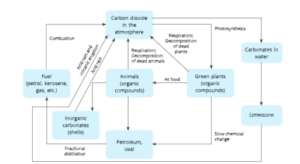
Carbon cycle in nature
When animals and plants die, their bodies are decomposed by decomposers and carbon dioxide is returned to the atmosphere.
- Burning of fossil fuels: Some of the dead plants and animals get buried deep under the earth. They changed into fossil fuels like coal and petroleum through slow chemical changes. Petroleum gives us fuel like kerosene, petrol, diesel, petroleum gas, etc. When these fuels burn, they give out carbon dioxide which goes into the atmosphere.
- Weathering of rocks: Some carbon dioxide is present in the dissolved state in water. This gets converted into calcium carbonate (CaCO3) in limestone and other carbonate rocks. Weathering of carbonate-containing rocks or treatment of their minerals gives out carbon dioxide. When acid rain falls on these rocks, then carbon dioxide is released.
- Volcanic eruptions: Volcanic eruptions and hot springs also release carbon dioxide into the atmosphere. Thus, there is a continuous exchange of carbon dioxide between atmosphere, water bodies, and living beings.
The different processes that help in the removal of carbon dioxide from the atmosphere are:
- Photosynthesis by green plants
- Formation f fossil fuels (like coal, petroleum, natural gas,
- Formation of carbonate rocks
- Formation of carbonate shells, skeleton, etc.
The different processes that help in the addition of dioxide to the atmosphere are:
- Respiration of plants and animals
- Decay of dead plants and animals
- Burning of fossil fuels
- Action of acid rain on carbonate rocks, shells, etc.
- Volcanic eruptions carbon
UP Board Notes for Class 10 Science Chapter 6 Photosynthesis Experiments On Photosynthesis
Destarching (removing starch)
Since the presence of starch is regarded as an evidence of photosynthesis, the experimental plant should not have starch in its leaves, before the experiment is started.
The leaves of a potted plant may be detached (devoid of starch) by leaving them in a dark place for 2-3 days (48 to 72 hours).
To conduct experiments on plants in open, the selected leaves on a plant must be detached by wrapped in aluminum foil for 2 days and then experimented upon.
UP Board Notes for Class 10 Science Chapter 6 Photosynthesis Experiment 1
To test a leaf for the presence of starch (iodine test)
- Detach a fresh green leaf and dip it in boiling water for 1 minute. Boiling will kill protoplasm and enzymes In it so that no further chemical change takes place. Boiling will also make the cell more permeable to water.
- Now boil the leaf in a test tube containing methylated spirit in a water bath till it becomes colorless or pale white due to the removal of chlorophyll.
- The leaf now becomes brittle and hard. Place it again in boiling water to make it soft again. Spread the leaf flat on a white surface such as a glazed tile or a Petri dish and pour a few drops of iodine solution (iodine 0.3 g: potassium iodide = 1.5 g and water = 100 mL) on the leaf surface. What do you observe?
- You will observe that the part of the leaf having starch becomes blue-black, while, the part of leaf without starch becomes brown in color.
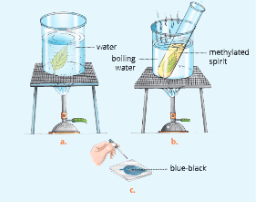
Experimental set-up to test a leaf for the presence of starch
UP Board Notes for Class 10 Science Chapter 6 Photosynthesis Experiment 2
To show that chlorophyll is necessary for photosynthesis.
- Take a plant with variegated leaves (which have chlorophyll only in patches). Such leaves can be found in plants like Coleus, Tradescantia, Croton, etc.
- Distarch the leaf by placing the plant in dark for 2-3 days.
- Place the plant again in daylight for a few hours. Detach the leaf and test this leaf for presence of starch.
- Only the parts which were green previously, turn blue-black with iodine solution. This shows that chlorophyll is necessary for photosynthesis.
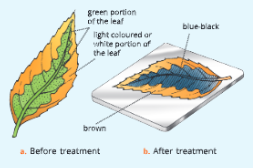
Experimental set-up to show that chlorophyll is necessary for photosynthesis
UP Board Notes for Class 10 Science Chapter 6 Photosynthesis Experiment 3
To show that sunlight is necessary for photosynthesis.
- Take a potted plant and destarch its leaves by keeping it in dark for 2 days.
- Take black paper and cut simple ‘L’ shape in it making a stencil. Cover one leaf on either side with one such paper by clipping it. Leave the set up in daylight for 4-6 hours.
- Detach the leaf and test it for the presence of starch. You will observe that only the part of the leaf that could get light through the cut-out design and the other exposed parts of the leaf turn blue-black with iodine solution, showing the presence of starch in it. This proves that sunlight Is necessary for photosynthesis.
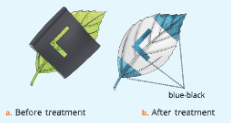
Experimental set-up to show that sunlight is necessary for photosynthesis
UP Board Notes for Class 10 Science Chapter 6 Photosynthesis Experiment 4
To show that oxygen is given out during photosynthesis.
- Take some water plants such as Elodea or Hydrilla and place them in a beaker containing pond water.
- Cover these plants with a short-stemmed inverted funnel. Slightly raise the level of funnel above the bottom of the beaker to allow free circulation of water. Insert a test tube full of water over the stem of the funnel.
- Place the apparatus in sunlight or bright light and observe.
- You will observe that bubbles of gas appear from the cut ends of stems, rise and collect in the test tube. Test the gas in the test tube by introducing a glowing splinter. The splinter bursts into flames showing oxygen is present in the test tube. Alkaline pyrogallol can be also used for testing the presence of oxygen. Thus, it is proved that oxygen is produced during photosynthesis.
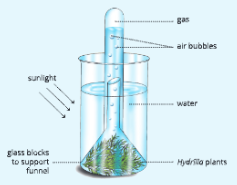
Experimental set-up to show that oxygen is produced during photosynthesis
UP Board Notes for Class 10 Science Chapter 6 Photosynthesis Experiment 5
To show that carbon dioxide (CO₂) is necessary for photosynthesis (Moll’s half leaf experiment).
- Take a potted plant with detached leaves. Take a conical flask and put some potassium hydroxide into it. Potassium hydroxide absorbs the carbon dioxide. Insert one leaf into this conical flask through a split cork.
- Leave the set-up in sunlight for few hours.
- After few hours take out this leaf from conical flask. Take one more leaf from the same plant. Test both these leaves for presence of starch.
- You will observe that leaf in the conical flask does not turn blue-black while the one that was exposed to atmospheric air turns blue-black.
This shows that carbon dioxide is necessary for photosynthesis.

Experimental set-up to show that carbon dioxide is necessary for photosynthesis
UP Board Notes for Class 10 Science Chapter 6 Photosynthesis Summary
- All green plants prepare their own food, hence, the Hydrogen ions produced due to splitting of water are called producers or autotrophs. combine with NADP to produce NADPH.
- The process by which living cells of plants containing chlorophyll manufacture their own food (carbohydrate) using CO₂ and water as raw materials in the presence of sunlight is called photosynthesis. Oxygen is released as a by-product during photosynthesis.
- Photosynthesis provides food for living beings directly or indirectly and produces oxygen.
- Chlorophyll o and chlorophyll b are most important as they receive light energy from the sun to bring about splitting of water molecules during photosynthesis.
- Chlorophyll pigment is present in chloroplast. Chloroplasts contain two main parts-stroma and grana.
- Photosynthesis occurs in two phases – light-dependent reaction and light-independent (dark) reaction.
- Light-dependent reaction (also called photochemical phase) occurs in thylakoids of grana of chloroplasts.
- Light reaction includes trapping of light energy by chlorophyll, splitting of water, and formation of ATP from ADP.
- Light-independent (dark) reaction is a biosynthetic phase which occurs in the stroma of chloroplasts. This reaction does not require light energy.
- During the dark reaction, NADPH molecules and ATP molecules both produced during light reaction, are utilized to produce sugar (C6H₁206) from carbon dioxide.
- Dark reaction occurs simultaneously with light reaction. and the time gap between the two is less than 1/1000 of a second.
- As a result of photosynthesis, glucose, water and oxygen are produced. Glucose is either immediately used up by cells or is stored in the form of starch, sucrose, and cellulose. Oxygen diffuses out into atmosphere which is used by living beings for respiration.
- Light intensity, CO₂ concentration, and temperature affect the rate of photosynthesis.
- Carbon cycle involves a series of chemical reactions through which carbon dioxide is circulated in nature.
